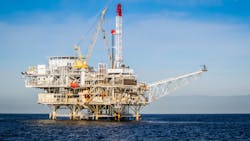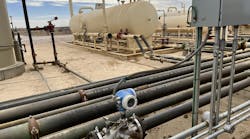Offshore oil platforms face some of the most demanding environmental and operating conditions out there. There is constant exposure to extreme temperature ranges, saltwater, severe storms and corrosive spray. These rigs typically operate around-the-clock, reaching thousands of feet down into the water and then drilling through multiple geologic layers for well exploration and production.
Under these hazardous and challenging conditions, offshore rig operators need rugged and reliable instruments to help measure, monitor and safely control all their complex systems. Accurate flow measurement of the delivery of drilling fluid at controlled high pressures is one of the most critical drilling rig system requirements.
Monitoring drilling fluid is critically important
Drilling fluid, also called mud, is a complex, often proprietary chemical mixture that performs multiple functions when drilling a well. It is typically a heavy, viscous mixture, with many types of fluids used on a day-to-day basis. Some are water-based, some are oil-based or synthetics, and all can incorporate a range of additives, such as lubricants, shale inhibitors and fluid-loss materials.
Different types or combinations of fluids are used as substrate conditions change. Fluid management involves a complex delivery and recirculation system that performs several functions during drilling. These include:
- Cleaning the hole by transporting drilled cuttings to the surface, where they are removed from the fluid before it gets recirculated down the bore hole.
- Supporting and stabilizing the walls of the wellbore until casing can be set and cemented into the wellbore.
- Preventing or minimizing damage to the producing formation.
- Cooling and lubricating the drill string and bit.
- Transmitting hydraulic horsepower to the bit.
- Providing rig operators with information about the producing formation through cuttings analysis, logging-while-drilling data and wireline logs.
Value of variable area flow meters
While there are a range of options for monitoring drilling mud flow, one of the most effective and reliable tools is the metal tube variable area (VA) flowmeter. VA flowmeters are extremely versatile and widely used in a range of industrial applications — particularly in chemical plants, oil refineries and offshore rigs — to measure and control applications involving high fluid flow rates and pressures. The basic technology, first developed over a century ago, provides a simple and reliable means to measure fluid flow.
The main elements of a VA flowmeter include the tube and the float. The tube is fixed vertically, and the fluid is fed from the bottom. The float inside the tube moves in proportion to the rate of fluid flow and the area between the tube wall and the float. When the float moves upward, the area increases while the differential pressure decreases. A stable position is reached when the upward force exerted by the fluid is equal to the weight of the float. This enables measurement of the flow rate by a scale, or a mechanical or magnetic follower connected to the float and driving a meter display external to the tube.
Due to the conditions in offshore drill rig applications, metal tube VA flow meters are typically specified. They are suitable for temperatures and pressures common in these environments and are generally manufactured of stainless steel, aluminum or brass. For offshore applications, well-constructed VA flowmeters typically use 316/316L Dual Certified stainless steel with Alloy 625, Hastelloy C-276 or Titanium GR II.
Easy to install, use and maintain, VA meters offer many benefits in flow-metering solutions:
- No power required — A majority of VA applications are mechanical indicator-only, and therefore no power is needed to measure flow. Costly wiring is not required and the VA meter can be installed in any hazardous area.
- Low pressure drop — VA meters can be installed in multiple locations over one process line without significant pressure loss.
- Repeatability — VA meters are often used for flow measurement due to high repeatability of measurement.
- Cost-efficiency — VA meters are generally lower in initial cost as well as lifetime costs, with little need for maintenance.
- Versatility — Manual control valves are available, from very small meter sizes to two-inch line size meters.
- Material availability — Options are available for different types of metal tubes.
Role of VA flow meters in fluid systems
Given these key functional and operational features, many offshore rigs utilize metal tube VA flowmeters to monitor and control drilling fluid flow rates. Devices like the MT3809 VA flowmeter from Brooks Instrument offer key advantages for consistent, repeatable pumping of drill mud under severe process conditions.
They are engineered and manufactured for years of use, with corrosion-resistant and stainless-steel housings that can withstand high pressures up to 885 bar. They are also designed for reliable performance, regardless of the range of drilling fluid mixtures used throughout the drilling process, which can change as conditions change in the producing formation.
Once the mud reaches the drill bit, the mud will cool off and lubricate the bit and efficiently transport the cuttings back to the surface. VA flowmeters can support a range of temperatures, from -198°C/135°F to 420°C/788°F, ideal for the broad span of temperatures encountered on offshore rigs.
Considerations for specifying VA flow meters
When selecting VA flowmeters for use in drilling fluid systems, it is useful to understand several key criteria to determine if the device provides the right performance and control the system requires. These considerations can include:
Application flow rate: Knowing an application’s required flow rate is necessary when specifying a VA meter. The goal is to select a VA meter where the normal operating flow is in 60% to 80% of the meter’s range, because a VA meter is more accurate in the upper part of its range. Additionally, the meter must also handle the minimum and maximum flows. The other important component of flow rate is units. If the unit is too small for the meter selected, the flow number can be minuscule or too large.
Fluid density and viscosity: Physical characteristics of drilling fluids must be considered when specifying a VA meter. This can be a challenge if an offshore operation is using different fluids at different points in the well-boring process, due to a variety of operational and condition factors unique to that well — conditions that can change as the drill operators analyze data from the drilling cuttings.
Fluid density and viscosity are important because these two values allow engineers to select the right meter size. Performance data is usually collected on different VA meters so that manufacturers know which ones will fit the supplied process conditions (density and viscosity).
Accuracy: VA meter accuracy is computed using a full-scale accuracy method rather than one of rate accuracy. VA meters are much more accurate in the upper end of a flow range, but more VA meters are used for repeatability of flow measurement. This means, given the same process conditions, the float will repeat and be at the same scale reading.
Selecting the right flow meter solution
Every offshore drill platform has unique environmental- and geologic-producing conditions that determine the composition of the drilling fluid and the operation of the fluid system. These conditions can affect VA flowmeter selection, including how many meters to incorporate in the system and how their output should be integrated into drilling control operations.
There are advantages to working with an instrumentation provider that has extensive experience with flow measurement and control devices in rugged offshore applications. This includes companies like Brooks Instrument, which can offer a robust global service and support infrastructure if device servicing or calibration is needed, or if replacement flowmeters are needed quickly out in the field. It is also important to choose a flowmeter supplier who can provide applicable approvals for your specific hazardous environment and conditions. Brooks Instrument, for example, has a dedicated certifications resource webpage and a team of experts to help users get the approvals they require.
To be successful and bring producing wells online, offshore drilling rigs need precise and reliable control of their drilling fluid systems. The metal tube VA flowmeter provides rugged, proven performance, as well as simplicity and ease of installation, to help ensure that drilling fluid systems operate with maximum efficiency and accuracy.
Kostas Sklikas is the global product marketing manager for Brooks Instrument.
Brooks Instrument





